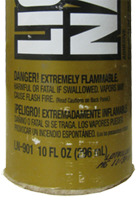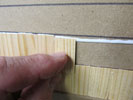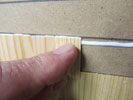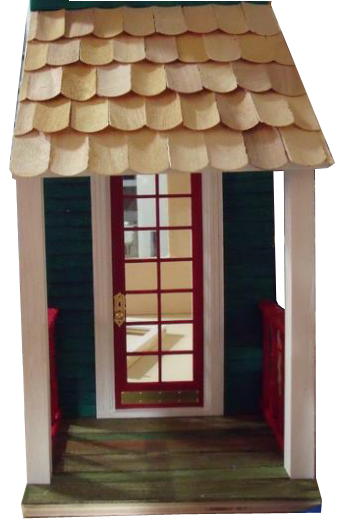All Glues:
Keep the line of glue high - just under the shingle guideline so squeezings are hidden by the next course of shingles.
Shingling with pre-dyed shingles is easier and less messy than dying the shingles later. All glues interfere with stain absorbtion, so dying first avoids light spots in the shingles.
Dying Shingles

Solvent-based Panel Cement: is still my 'most recommended' glue for shingling where availability and ventilation issues don't get in the way. Solvent-based panel cement has ventilation and flammability warnings on the front (see the photo at left).
If the bottom of the front label says “caution – flammable” then it’s solvent-based and won’t curl the shingles so shingling is faster.
(see "A more important concern" below)
Have a paper towel available to pinch the tip and keep it clean.
Some states are limiting availability of solvent-based construction adhesives. Here are some alternatives that I have used successfully:
Both hot-melt glue and panel cement have a learning curve that starts out messy (practice with scraps of paper so you're not wasting shingles you will need).
Hot Melt glue will burn your fingers, it drips, and it leaves spider-webs of strings that will ruin a window pane.
Shingling with Tacky Glue another
 Dip the top
Dip the top Smear upward
Smear upward
Thin Shingles and in-attentive gluing technique with White Glue made these shingles curl and become unstable:

![]()
Tacky glue has water in it and it is slower than hot-melt or panel cement to stiffen its hold on the shingles.
Glue with water in it curls shingles. The amount of the curl might not be much – it can give more texture to the shingles which isn’t necessarily bad. If used carefully it doesn’t curl enough to show the plywood under the shingles, but that is something to keep in mind (and maybe color the plywood before shingling). To minimize the curling the glue must be applied in a thin worm just below the guideline, and the shingles dipped into that worm and smeared upward to the guideline - keep the glue right at the top of the shingle so it doesn’t carry much water into the shingle… water curls shingles and less water curls them less. The photos on the left show the upward smear of the glue that will minimize curling. (See also "Dip, Scoop, Slide")
A more important concern of the curling is that the shingles aren’t touching each other side-to-side anymore. Touching each other is what stabilizes them when they are bumped; not touching means they can be more easily knocked out of position, and they are very difficult to re-position once that happens. To control that vulnerability, I let each row of shingles dry for 20 minutes or so before I start the next row. If I go all the way around the roof I have used up an appreciable piece of that drying time, but I will still test the next-lower row for stability before I begin another.
- Clear Silicone glue (like E6000 or Goop)
- Clear Silicone caulk (like DAP)
- Epoxy or Resorcinol glue
- Quick Grip cement
- Duco cement
- Super glue